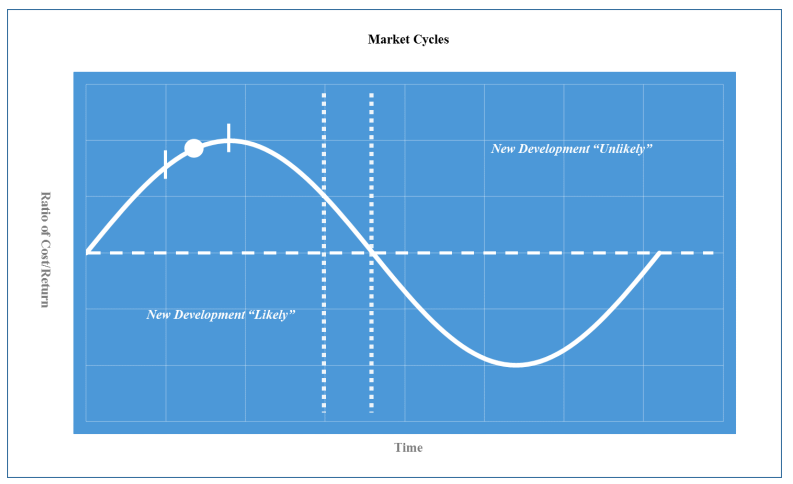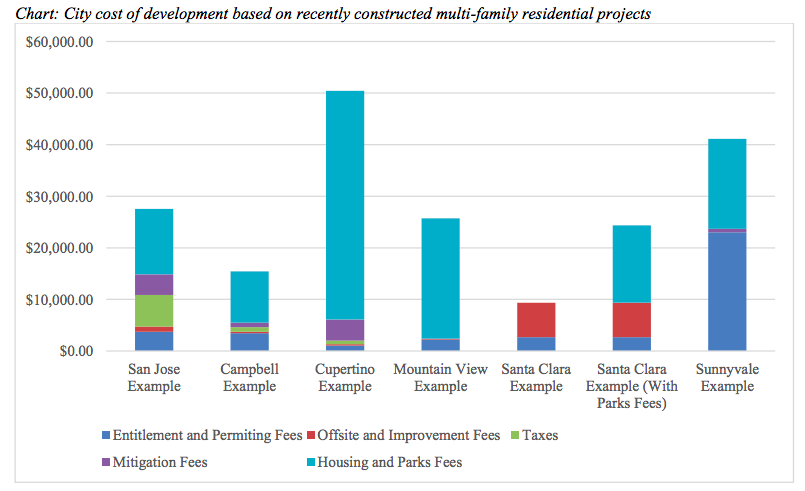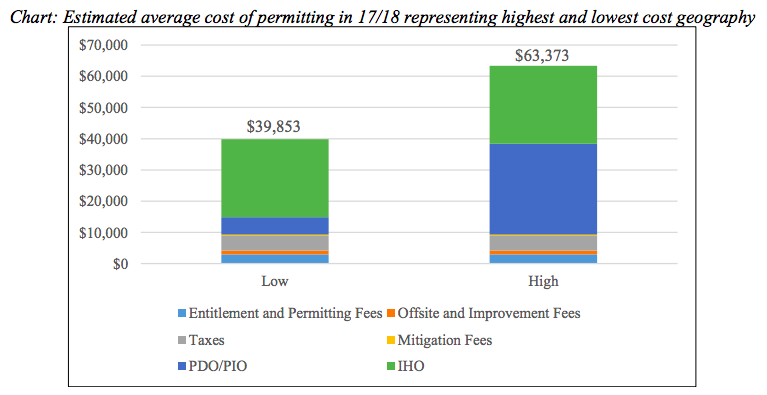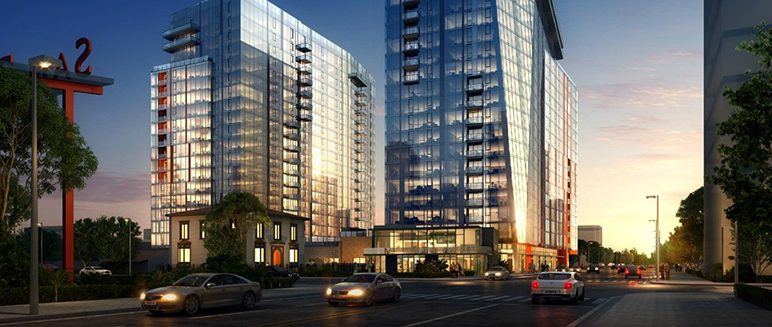A new study suggests that rising construction costs related to a labor shortage and President Trump’s tariff plan may hinder high-density housing development in San Jose, where residents already grapple with a crippling affordability crisis.
The report by consultants at Keyser-Marston Associates, which comes up for review at Tuesday’s City Council meeting, predicts that rents would have to ascend even higher to make residential tower construction profitable for investors.
In a study session last week, city officials learned that the average tenant would need to bear another 25 percent rent hike to make it economically feasible to build new high-rises. And according to a 38-page conceptual analysis by Keyser-Marston, estimated minimum profit targets for developers range from 10 to 15 percent of project costs.

Source: City of San Jose
Responding to those findings, Mayor Sam Liccardo told the Mercury News last week that the city might need to slash developer fees to counteract market forces.
Economic Development Director Kim Walesh and Planning, Building and Code Enforcement Director Rosalynn Hughey prepared a memo for the council that outlines the aggregate impact of city fees on housing construction. Their analysis shows that while San Jose has one of the most robust real estate markets in the U.S., development in most parts of the city remains unlikely without extenuating circumstances such as long-term land ownership or self-financing with expectations of a return over a longer time period.
Though land and construction costs are comparable in neighboring cities, higher rents in Cupertino, Palo Alto and other job centers make them more attractive to new investment, according to Hughey and Walesh.
“These economic conditions favor development in neighboring cities because projects there will bring higher returns,” they write. “While speculative development remains unlikely in many parts of San Jose at this time, the economy is continuing to expand and create demand for housing. In the current economic climate, it’s unlikely that development and land costs will undergo a major reset sufficient enough to begin moving the ratio between cost and return back towards feasible development.”

Source: City of San Jose
Higher rents or higher sales would be needed to offset rising construction costs, they conclude. But the only incentives the city can control, of course, are taxes and fees, which comprise 10 percent of the value of a typical housing unit in new market-rate projects.
In some cases, per Keyser-Marston, even eliminating all city fees would yield a negative return in some parts of San Jose. Only in the city’s West Valley area are residential projects considered economically viable, their report found.

Source: City of San Jose
Park advocates and environmental groups express concern about the assessment potentially prompting the city to slash developer fees that fund open space. In a letter signed by the Committee for Green Foothills, Sierra Club and Audubon Society, advocates note that San Jose still has 51 underserved neighborhoods that are more than a third of a mile away from a park, trail or open space. Additionally, they note, the city has a $293 million backlog of parks-related infrastructure repairs.
“The staff report states that city fees and taxes have only a marginal impact on development feasibility, with the major drivers of feasibility being construction costs and available return,” they write. “Additionally, San Jose’s development costs are in line with surrounding cities. We believe that parks are as much an essential part of livable cities as police protection and road maintenance. San Jose needs to not only maintain, but [also] increase its current level of funding for parks in order to truly be a world-class city.”
More from the San Jose City Council agenda for May 1, 2018:
- Downtown storefronts that remain empty for more than a month may end up automatically registered in a program that charges a vacancy fee. Councilman Raul Peralez spearheaded the vacant storefront program, which launched last fall and charges property owners $220 per quarter for as long as a space isn’t leased out. The point of the program is to reduce blight.
- The council will consider whether to endorse a privately financed effort to build a reconstructed light tower modeled after a similar monument built in 1881.
WHAT: City Council meets
WHEN: 1:30pm Tuesday
WHERE: City Hall, 200 E. Santa Clara St., San Jose
INFO: City Clerk, 408.535.1260


Nice reporting Jennifer, as always.
One thing that seemed to be missing (unless I missed it) is why exactly is the cost the construction going up faster than inflation? Labor costs? Something else?
That’s a good question. My dad’s a roofer, so this hits home for me.
From what I’ve read, the biggest factor driving up costs is a lack of skilled workers, which forces developers to offer higher wages.
Of course, that’s a welcome change for workers in an industry that’s struggled to retain talent because of decades of stagnant wages.
Developers got addicted to cheap labor, which drove a lot of people away from the industry.
Now that they need more workers, they’re going to have to offer better incentives to attract the talent they need to help us build our way out of this housing shortage.
The trades have not struggled to “retain” talent, they have struggled to find new talent due to the housing shortage in the area. Skilled workers have to drive farther and longer each day for work. Hence Labor costs more. So how do we break the cycle??
I think this article is starting down the right path by recognizing that Government is part of the problem, not part of the solution.
It doesn’t seem like slashing developers fees would make up for these increasing labor costs.
The economics here is fascinating – the conventional “build our way of housing shortage” only works if the new housing stock is affordable and not 25% more. It seems like new high rises would just go the Googlers and not the teachers, firefighters, etc. that are being driving out of San Jose.
It seems like the “affordable housing” slogan will just be good PR used to get developers a better deal from the city, a few token “affordable units” in each building for the press releases, but no fundamental move towards a San Jose that works for everyone, not just those at the very top.
“Now that they need more workers, they’re going to have to offer better incentives to attract the talent they need…” Also, more people including potential employees and those who influence them such as friends and family will need to get over the stigma of working in the trades.
> why exactly is the cost the construction going up faster than inflation? Labor costs? Something else?
Here’s a clue:
https://www.sfchronicle.com/business/networth/article/Yes-median-pay-at-Facebook-really-is-about-12870786.php
“Yes, median pay at Facebook really is about $240,000 a year”.
If someone has a career choice between working at Facebook or working in construction, what do you think they’re going to do?
That’s a false choice. The skill set possessed by a construction worker is not the skill set for a Facebook worker.
>: The skill set possessed by a construction worker is not the skill set for a Facebook worker.
The market place for employment skills is a daisy chain.
It doesn’t have to be an “either or choice” for specific individuals.
There are people with law degrees who could be debt collectors, and debt collectors who could also be rodeo clowns. Just depends on which pays more.
Now comes the “public conditioning” articles on the manufacturing consent to cut deals with developers, right on queue (if not a bit early) as predicted in previous posts.
First, Ms. Wadsworth, Ramona Giwargis, SJI and the Merc vilify the mom and pops, who then sell to developers because these regulations set them up for foreclosure in a downturn, and then the city cuts deals with developers because of “higher costs”. Like it didn’t cost $500K to build a unit 3 years ago when this whole “narrative” started.
This has been a long con to remove the speed bump that is the small business person all along. All with the help of the “alternative” news, played like a fiddle. Especially Ms. Wadsworth (who has been the go-to shill for the perpetrators of this legal theft like Dir Jacky Morales-Ferrand, Dr. Wayne Chen, Shaunn Cartwright, and other “activists”), whose own father is a small business person. Just like in Wall Street, life imitates art.
Thanks. You should be proud.
Well said!
Thank you.
“Downtown storefronts that remain empty for more than a month may end up automatically registered in a program that charges a vacancy fee. Councilman Raul Peralez spearheaded the vacant storefront program, which launched last fall and charges property owners $220 per quarter for as long as a space isn’t leased out. The point of the program is to reduce blight.”
How can SJ voters continue to vote for such economic illiteracy? Why do they put so much power into candidates that have no clue on how hard it is to run a business or manage a property. Why are the storefronts vacant? Because of ridiculous licensure requirements, cost of regulations, and price controls on labor. Should San Jose look into helping property owners by making it easier for their tenant to start a business, yes? Will they, no, that takes thought, creativity, humility. What they will do is punish property owners with more penalities.
This is a foolish abuse of power to boost this politician’s over-inflated ego.
> How can SJ voters continue to vote for such economic illiteracy?
Because SJ voters are stupid and easily manipulated.
“Democracy” is government by the stupidest and most easily manipulated fifty-one percent of the population.
The reason housing is so expensive in the Bay Area is because there is not enough of it, period.
So why is there not enough housing? The “Green Belt”? Permits? Fees? Environmental Reviews? Mandatory Affordable Housing Units? Rent Control? Living Wage? All of these things weigh on an investors decision to sink their money into Housing in the Bay Area. When the weight of these things (in total) sways an investor away from investing in housing here, we end up with a lack of housing. Everything else is just a symptom of the root problem. Fix the problem and the symptoms will take care of themselves.
Hmmm….so when will there ever be enough housing in the Bay Area? How much is enough? According to developers, investors, and paid for gov’t employees the answer they proudly stand by is never, hence, keep the money machine running and everything will work out.
There would be more than enough housing in the Bay Area, except that the interference from the local governments causes a shortage.
For most of the past fifty years the available housing and tenants in need of housing has been roughly in balance. It’s only since the Great Recession that the vacancy rate has been so low for so long. But typically, it’s been easy to find a place to live.
It’s also easy to conflate rent costs with availability, but they’re separate issues. Usually there’s been available housing, but there is always upward pressure on rents. The cause of higher rents is due to interest rates and land availability, but the reason for the extremely low vacancy rate is due to excessive government regulation.
Government regulation should not be discounted; it’s a big factor, and government workers know that more rgulations mean job security, since regs almost never go away, they just keep accumulating. And of course, the government has to enforce them.
Most government housing regulations could be modified, or completely dispensed with. If we just kept safety regs, and some reasonable zoning regulations, and then let the free market provide housing, we wouldn’t have the current housing shortage.
Why are building heights regulated? Many cities have forty or fifty storey buildings, and some are much higher. Typically, 12 – 24 houses require an acre or more of land, while the same acre can often support more than a hundred housing units. But government regulation makes it extremely difficult for builders to put up tall buildings.
If builders were allowed to put up just one hundred high rises in the Bay Area, that would make a huge difference in the vacancy rate because rents are set at the margin.
The problem is that governments do not want fewer, or more reasonable regulations. The proof is in their refusal to permit more efficient use of the available land. The government is the primary reason for the low vacancy rates, and local governments do their part to keep the rents as high as they are.
But there are local elections coming up, and if tenants put the heat on candidates, that could make a big difference. But if tenants continue to buy into the fallacy that builders don’t want to build, they will continue to get what they’ve been getting.
And lets not forget the city’s own venture into commercial retail space hit the ground like something out of a tall cow’s ass. Referring to the retail space extension along 4th street that sat empty for years because of city mandated labor pay scales demanded of any little retail that moved into these spaces. so now what should be a hot diggity retail store front is an “art viewing” space (for lack of a better term) and from the looks of the operation (no offense) but I don’t they are paying the city any rent for the prime time space.
Its always fun to watch the sh*t hit the fan whenever government tries to get involved with the realities of real life capitalism – which is a terribly flawed economic system – but unfortunately the best one ever devised yet – – and mom and pop stores might be able to make a go of things downtown – if the city knuckleheads would just get out of the way.
High rents > Higher Living Wages > Higher Construction Costs > Higher Rents …
Guess which part of this cycle is caused by government intervention?
From the article:
Economic Development Director Kim Walesh and Planning, Building and Code Enforcement Director Rosalynn Hughey…
See the problem?